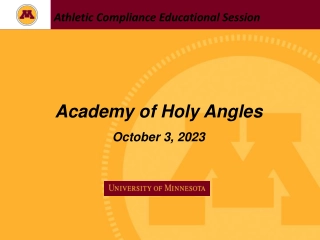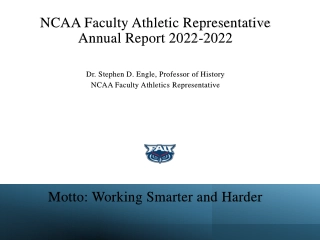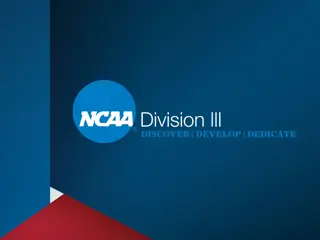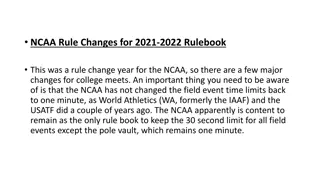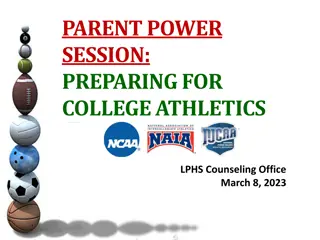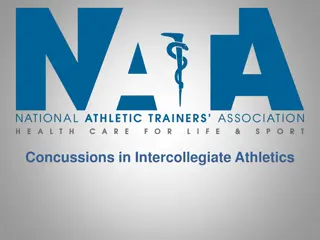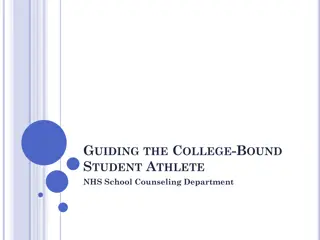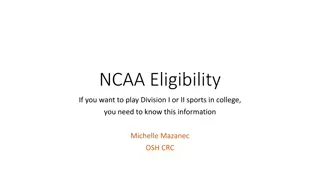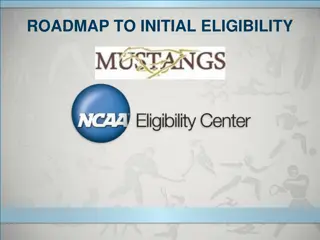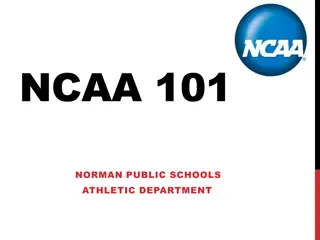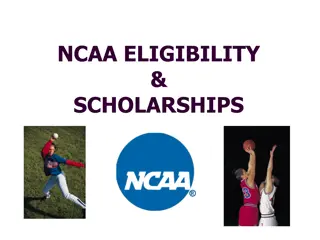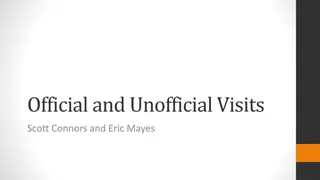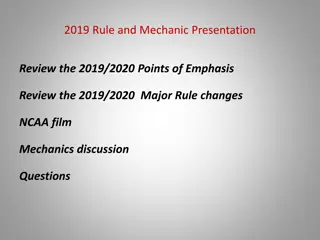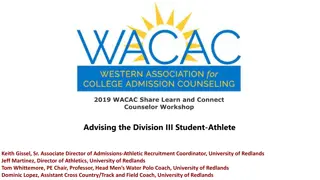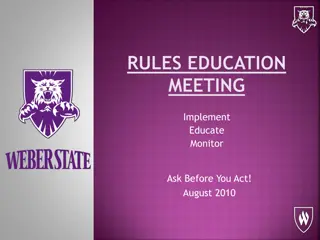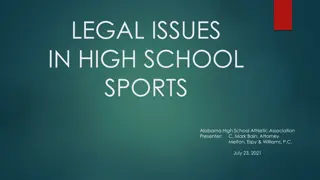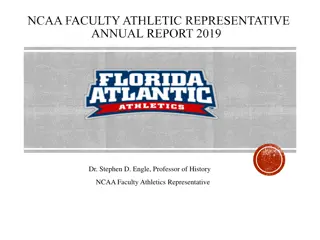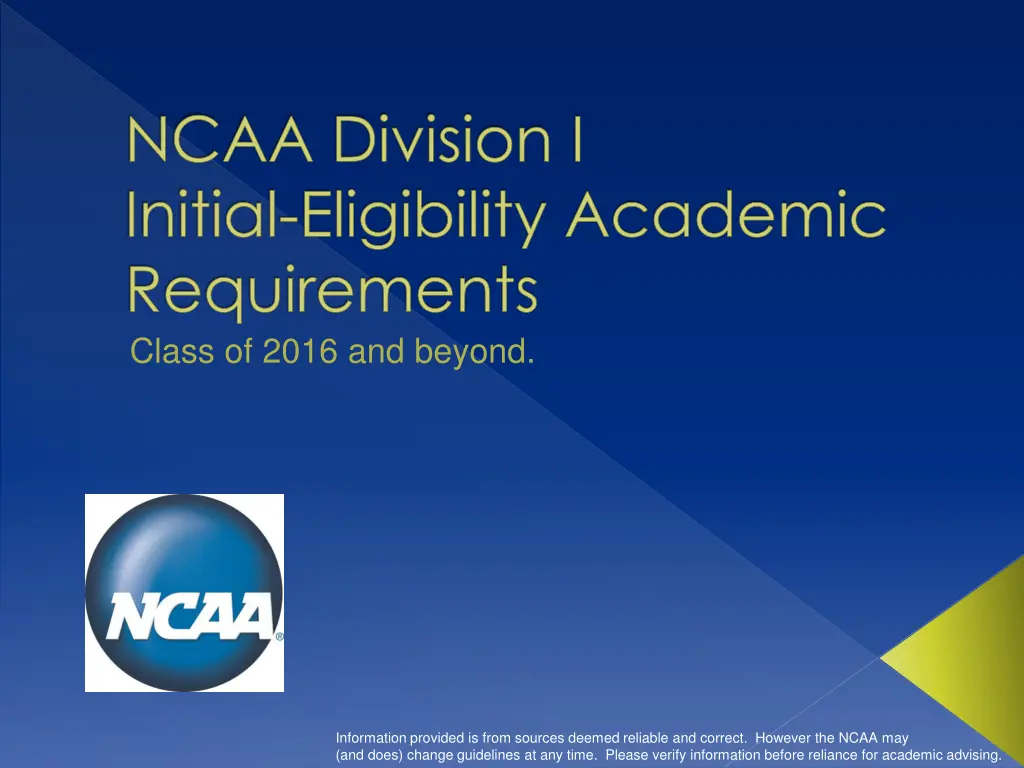
NCAA Division I Initial Eligibility Academic Requirements for Class of 2016 and Beyond
"Understand the new NCAA Division I academic eligibility requirements for students enrolling in 2016 or later. Explore changes in core course GPA, course requirements, and more to ensure successful participation in athletics."
Download Presentation

Please find below an Image/Link to download the presentation.
The content on the website is provided AS IS for your information and personal use only. It may not be sold, licensed, or shared on other websites without obtaining consent from the author. If you encounter any issues during the download, it is possible that the publisher has removed the file from their server.
You are allowed to download the files provided on this website for personal or commercial use, subject to the condition that they are used lawfully. All files are the property of their respective owners.
The content on the website is provided AS IS for your information and personal use only. It may not be sold, licensed, or shared on other websites without obtaining consent from the author.
E N D
Presentation Transcript
NCAA Division I Initial-Eligibility Academic Requirements Class of 2016 and beyond. Information provided is from sources deemed reliable and correct. However the NCAA may (and does) change guidelines at any time. Please verify information before reliance for academic advising.
New NCAA Division I Initial- Eligibility Academic Requirements There will be new requirements for college-bound student-athletes enrolling full time at an NCAA Division I institution on or after August 1, 2016. *Note: 9th graders, beginning in the 2012-13 academic year, will be the first graduating class impacted. High School NCAA Division I
NEW NCAA Division I Initial- Eligibility Academic Requirements For the Class of 2016 and beyond, there are three possible academic outcomes: 1. Full Qualifier = competition, athletics aid (scholarship), and practice the first year. 2. Academic Redshirt = athletics aid the first year, practice in first regular academic term (semester or quarter). 3. Nonqualifier = no athletics aid, practice or competition the first year.
Summary of Changes Full Qualifier Minimum core-course GPA of 2.300 required (was 2.0); Change in GPA/test score index (sliding scale); and 10 of the 16 core courses required before beginning of senior year. These 10 courses are locked in for purposes of GPA calculations, 16 required core, etc.
Full Qualifier: Requirements for Athletics Aid, Practice and Competition Students will need to meet the following requirements to receive athletics aid, practice and compete their first year: 16 core courses in the following areas (no changes from previous reqs): 4 years English; 3 years math at Algebra I level or higher; 2 years natural or physical science (one lab if offered at any high school attended); 1 year additional English, math or natural/physical science; 2 years social science; and 4 years additional from areas above or foreign language, philosophy or comparative religion. Minimum required GPA: Minimum GPA of 2.300 in those 16 core courses.
Full Qualifier: Requirements for Athletics Aid, Practice and Competition Competition sliding scale. (The full sliding scale can be found at www.eligibilitycenter.org under Resources .) Minimum sum ACT or SAT (critical reading and math only) score that matches or exceeds the student-athlete s 16 core-course GPA requirement. o Example: 2.50 core-course GPA requires 1000 SAT or 85 ACT. o Example: 2.95 core-course GPA requires 820 SAT or 68 ACT.
Full Qualifier: Requirements for Athletics Aid, Practice and Competition Core-course progression. Must complete 10 core courses before seventh semester of high school (i.e., Fall of senior year). Of the 10 core courses completed, 7 must be in the area of English, math, or science. These 10 core courses become locked in for the purpose of GPA calculation. o A repeat of one of the locked in courses will not be used if taken after the seventh semester begins. * Anticipate international PSA s will be exempt from the 10 core course timing due to intricacies of foreign credentials
Sliding Scale for Competition (Abbreviated) SAT (critical reading/m ath only) SAT (critical reading/math only) GPA for Competition ACT Sum GPA for Competition ACT Sum The full sliding scale can be found at www.eligibilitycenter.org under Resources . 4.000 400 37 2.900 840 70 3.900 440 41 2.800 880 73 3.800 480 43 2.700 920 77 3.700 520 46 2.600 960 81 3.600 560 48 2.500 1000 85 3.500 600 50 2.400 1040 88 3.400 640 53 2.300 1080 93 3.300 680 56 3.200 720 59 3.100 760 62 3.000 800 66
Academic Redshirt: Requirements for Scholarship and Practice. 16 core courses in the following areas (no change): 4 years English, 3 years math at Algebra I level or higher, 2 years natural or physical science (one lab if offered by any school attended); 1 year additional English, math or natural/physical science; 2 years social science; and 4 years additional from areas above or foreign language, philosophy or comparative religion. Minimum required GPA (old standard). Minimum GPA of 2.000 in 16 core courses. Academic redshirt sliding scale (old standard). Minimum sum ACT or SAT score (critical reading/math only) that matches the 16 core-course GPA. o Example: GPA of 2.50 requires SAT of 820 or ACT of 68.
Sliding Scale for Academic Redshirt (Abbreviated) Athletics Aid and Practice Only GPA for Aid and Practice 2.500 SAT (critical reading/mat h only) SAT (critical reading/mat h only) GPA for Aid and Practice ACT Sum ACT Sum 3.550 or above 400 37 820 68 The full sliding scale can be found at www.eligibilitycenter.org under Resources. 3.500 420 39 2.400 860 71 3.400 460 42 2.300 900 75 3.300 500 44 2.200 940 79 3.200 540 47 2.100 980 83 3.100 580 49 2.000 1020 86 3.000 620 52 2.900 660 54 2.800 700 57 2.700 740 61 2.600 780 64
Academic Redshirt: Requirements for Scholarship and Practice If a college-bound student-athlete meets these requirements, they can receive an athletics scholarship during their first year at a D-I institution. If they meet these requirements, they can practice during their first term at a D-I institution but not compete. After the term, in order to continue to practice for the rest of the year, the student must be academically successful at the collegiate level. (Definition?!)
Nonqualifier - What If A Student Does Not Meet Either Set of Requirements? If a college-bound student-athlete does not meet either set of requirements, they are a Nonqualifier. A Nonqualifier: Cannot receive athletics aid during the first year at an NCAA Division I college or university. Cannot practice or compete during the first year at a Division I college or university.
Two-Year College Transfer Academic Requirements
New NCAA Division I Two-Year College Transfer Academic Requirements Information for student-athletes that attend a two-year college before enrolling full time at an NCAA Division I college or university. High School Two-Year College NCAA Division I College
NEW Division I Two-Year College Transfer Academic Requirements These new requirements apply to students first enrolling in college full-time on or after August 1, 2012. Additional requirements for Qualifiers and Nonqualifiers: Increases the required two-year college transfer GPA from 2.000 to 2.500. Students are limited to two physical education activity courses from the two-year college to meet requirements in all sports. (*used to be the rule for basketball only)
NEW Division I Two-Year College Transfer Academic Requirements Additional requirement for high school Nonqualifiers only: Students will be required to complete three transferrable credits in science from the two-year college. This is in addition to the current requirements of three units of transferrable math and six units of transferrable English.
Transfer Review Two-Year High school Qualifiers: Minimum of one full-time term at two-year Minimum grade point average of 2.500 Average of 12 hours for each full-time term in attendance Not more than 2 credit hours of PE activity courses High school Nonqualifiers: Must graduate from the two-year Minimum of 48 transferrable-degree credit (40/60/80 Rule?!) 6 hours of transferrable English 3 hours of transferrable math 3 hours of transferrable science Minimum of 3 terms in attendance at two-year Minimum grade point average of 2.500 Not more than 2 credit hours of PE activity courses
Recruiting Two-Year Transfers Checklist for 4-year coaches: Qualifier or non-qualifier? Refer to eligibility flow chart! Presumed NQ until proven otherwise If assumed NQ, check terms of enrollment and English, math, science hours Check GPA regardless of qualifier status must have 2.5 GPA Look at types of classes; if numerous PE courses, only 2 activity courses are countable 4-year coaches should be able to review a two-year college transcript and identify key points above!
Two-year Transfer Flow Chart QUALIFIER? YES NO Minimum one full time term at two-year? Graduate from two-year? Effective August 1, 2012 for students enrolling in a two- year college for the first time on or after August 1, 2012 Minimum GPA of 2.500? Minimum GPA of 2.500? Average 12 hours for each full-time term? Minimum of 48 transferrable hours? 6 hours English 3 hours math 3 hours science Not more than 2 credit hours of PE? If YES to all above, SA is ELIGIBLE! If NO to any above, SA is INELIGIBLE! Minimum of 3 full-time terms in attendance? Not more than 2 credit hours of PE? If YES to all above, SA is ELIGIBLE! If NO to all above, SA is INELIGIBLE!
Update Year in Readiness Proposal NCAA Proposal #2011-65: Year of Academic Readiness at 2-year College Proposal was reinstated by the Board of Directors at their January meeting Proposal was subsequently tabled and the Board will reconsider the proposal and any amendments at the April Board of Directors meeting Stay tuned .
Questions and/or comments? www.ivc.edu/athletics Keith Shackleford, JD Dean Kinesiology, Health & Athletics

